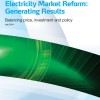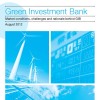Tariff costs, tariff types, and switching levels
Tariff rises continue to be of concern with the average dual fuel household bill rising from £1,057 in 2011 to £1,232 in 2012. These rises have been against a backdrop of low wage rate growth, employment uncertainty, and a general lack in consumer confidence, fuelling affordability concerns.
This report finds no evidence of regional pricing by the ‘big six’ companies, however, when analysing the differences between tariffs, it is found that the benefits of switching are relatively limited over time, with direct debit customers being the main beneficiaries. Looking at the rationale behind price changes, this report finds that the price reductions felt by consumers for direct debit tariffs are as a result of company’s pricing policies and not simply inflationary changes.
Energy trading, liquidity and self-supply
This report finds that over time there has been a shift towards short term, ‘spot’ trading with increased volatility and cost owing to the higher price that can be demanded on a short term transaction. These costs have then been passed onto consumers with little explanation from the energy companies or the regulator as to why increases in this kind of activity have been allowed to occur. Policy makers can no longer ignore such a shift, given the implications this has for affordability. As such, intervention is required to encourage more competitive, longer term trading on an open and transparent market.
There is also an increasingly vague view as to what the energy mix in the UK will be, creating uncertainty and holding back the investment the country needs. Whilst in theory, with the government remaining technologically neutral, competition should be encouraged. In reality it has created a situation where only the most certain of projects (those with the lowest financial, political and planning risk) progress, with all others prevented from progressing while investors continue to seek the right signals.
Consolidated Segmental Statements
This report analyses in detail the Consolidated Segmental Statements of energy companies and finds that the costs and earnings of the generation arms of companies varies more significantly than that of their energy companies supply businesses.
Economies of scale and efficiency are generally cited in favour of vertical integration in the energy sector, yet the analysis in this report calls into question whether the actual benefit is passed through the system to the consumer.
In some circumstances the results even suggest that costs move in opposite directions for the different divisions of energy companies (e.g. generation and retail/supply), demonstrating that pricing signals are not efficient and the system is not responding to them as would be expected. Part of the reason behind this may be that companies are responding to media pressures and attempting to control costs at one end of the system. This, however, fundamentally undermines price and investment signals within the market.
The analysis also calculates the ‘earnings’ premium that is applied as prices pass through the system. That is to say that if generators charge more to suppliers, suppliers in turn charge more to consumers. For every extra £1 a generator earns in profit, a supplier is also able to make an extra £0.57p, making a total increase for consumers of £1.57. Given that more than ‘base’ costs are passed onto consumers the case for vertical integration and the efficiencies it brings within the market appears uncertain.
The correlation between generators’ and suppliers’ weighted average costs shows that as the former’s average costs increase the latter’s average costs do not change significantly. This suggests two possible scenarios, the first being that the average weighted cost of generators has no bearing on suppliers’ average costs. Alternatively, supply businesses are able to hedge prices forward so effectively that they can absorb variations in generators weighted costs with little effect on their own. The second scenario is, however, questionable given the shift towards short term spot trading where it is more difficult to offset cost volatility.
International price comparisons and the effect of energy taxation
The UK is more or less exactly matching the IEA median for electricity prices, and has one of the lowest incidences of taxation on energy. As such, overall electricity prices in the UK may not be as overpriced as is feared. It also potentially indicates, that the UK is not proactive enough in reallocating resources from markets which are inefficiently accounting for the effects of climate change, pollution, and volatile prices, thus preventing movement towards a more stable and sustainable long term solution.
This report also compared the effects of taxation on the price of electricity and found that on average for every 1p increase per kWh in electricity taxes that occurs, there is also an increase of 0.53p in the electricity price. It should be noted, however, that this performance is significantly helped by Denmark, The Netherlands and Germany, where tax increases result in falls in electricity prices.
This compares with a rise of 7.4p per kWh in electricity prices for every 1p per kWh of extra taxes the UK government levies. This is also significantly more than any other country in the data sample below, with the next on the list (Ireland) experiencing an additional 4.3p per kWh rise for every extra 1p per kWh of taxation. The reason behind the UK’s poor performance in this area is likely to be that companies are ‘over insulating’ themselves against tax and policy changes, highlighting that long term policy certainty is key.
The evidence suggests that as the level of tax increases, so more investment takes place, the level and pace of research and development speeds up, and there is a lowering of long term costs, reducing the effect on electricity bills above and beyond the incidence of the tax.
The price of electricity in the UK on the ‘open’ market, i.e. not including tax, is one of the highest amongst the countries analysed. This is likely to be due to a lack of strategic planning as no one company considers investment in the UK as a whole at the macroeconomic level. As such, any investment outcome from the sector will favour individual companies’ investment strategies and not one that is efficient for the UK as a whole.
Policy – competition, EMR, CfD, capacity, price and consumers
This report suggests a way forward which attempts to balance the needs identified within the EMR framework, including:
The need for a policy which will secure a reasonable baseload and invest in solutions which can ‘store’ energy.
The need to address capacity issues without radically reforming policy again and therefore increasingly delay and uncertainty which is a major problem for investors.
Ways to improve and implement effective competition in the generation market by creating a secure base that lowers costs and allows technologies to compete where appropriate.
The need for increased transparency within the market, allowing the retail side to access and buy from a number of sources.
This report proposes that five Generation Investment Vehicles (GIVs) with a combined value of £8bn are created to ensure that in the short to medium term project finance is secured. In order to secure medium to long term investment to ‘lock’ long term cleaner energy into the UK’s generation system, this report also proposes that three Tidal GIVs (TGIVs) with a combined value of £21bn be created.
These vehicles could be used to finance for any type and combination of projects, for example:
Six CCGT plants at an approximate cost of £3bn (providing approx. 7,500MW).
Eight waste to energy plants at an approximate cost of £4bn (providing approx. 575MW).
£21bn of funds towards the building of tidal/lagoon assets (providing approx. 2,000MW to 3,000MW).
A £1bn fund for community projects, where money would be raised via crowd sourced funding.
The three £7bn TGIVs for example could finance:
The roll out of either smaller tidal schemes or more economically the construction of a Severn Barrage (with a target price of 16% below the current £25bn estimated cost) to lock in lower cost long term electricity not only for this generation but also the next few.
Introducing a secure supply has to be accompanied by increased transparency and ultimately improved competition within that part of the market where competition for variable electricity demand takes place.
This paper proposes a Priority Auction Mechanism (PAM) where:
A new structure of two open market traded exchanges where government has to purchase 50% of the capacity put forward in the first round, 75% in the second round, and all remaining capacity then having to compete OTC.
The first round of purchasing will be on contracts longer than 24 months, while the second will see providers enjoy contracts of longer than 12 months’ duration. This will have the dual impact of providing certainty of revenue for generators and encourage future investment whilst also encouraging a transparent and efficient pricing mechanism for the electricity market.
Company website:
http://www.acenet.co.uk/




